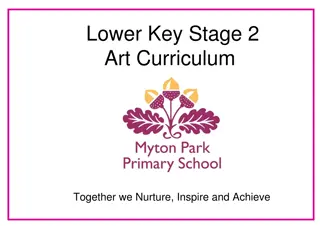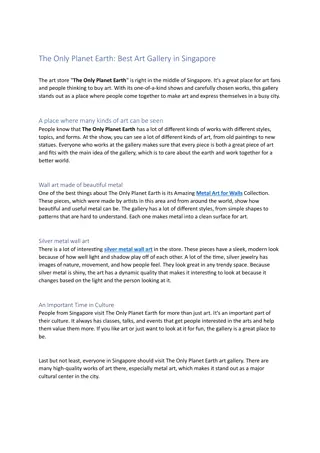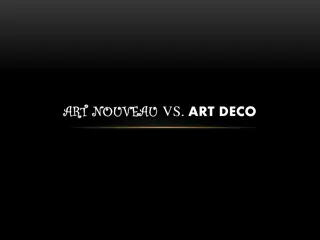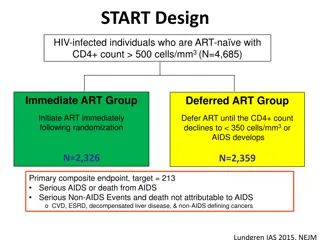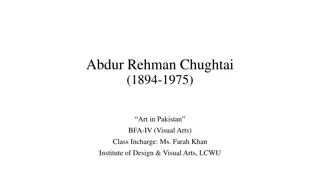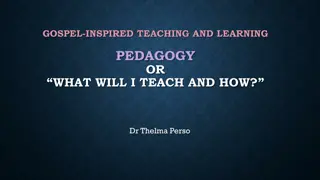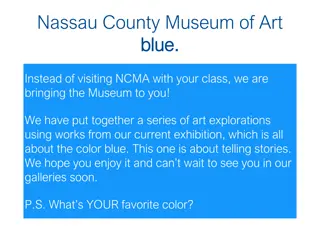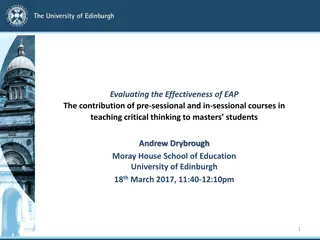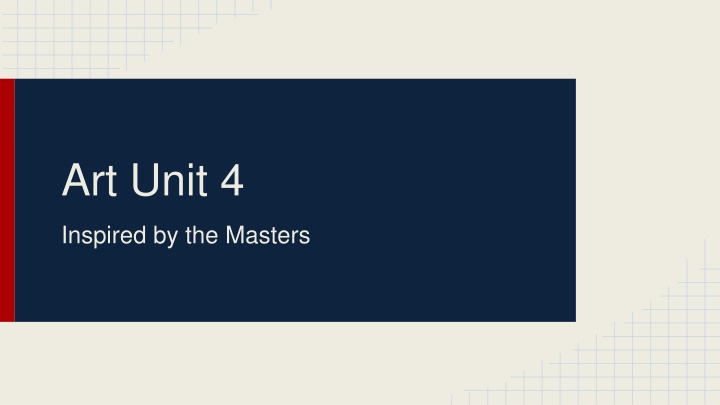
Creative Art Unit Inspired by Masters - Abstract, Dreamlike, Everyday Beauty
Explore a creative art unit inspired by masters like Jackson Pollock, Marc Chagall, Norman Rockwell, Alexander Calder, and Georgia O'Keeffe. Students engage in activities ranging from expressing emotions through abstract work to creating dreamlike images, appreciating everyday beauty, finding visual and physical balance, and simplifying subjects to give them power. Discover the unique journeys of these influential artists and unleash your creativity in a variety of artistic endeavors.
Download Presentation

Please find below an Image/Link to download the presentation.
The content on the website is provided AS IS for your information and personal use only. It may not be sold, licensed, or shared on other websites without obtaining consent from the author. If you encounter any issues during the download, it is possible that the publisher has removed the file from their server.
You are allowed to download the files provided on this website for personal or commercial use, subject to the condition that they are used lawfully. All files are the property of their respective owners.
The content on the website is provided AS IS for your information and personal use only. It may not be sold, licensed, or shared on other websites without obtaining consent from the author.
E N D
Presentation Transcript
Art Unit 4 Inspired by the Masters
Jackson Pollock Week 1 Finding Inspiration from Emotions Students will have a brief lesson in the biography of American Artist Jackson Pollock and his process of portraying his emotion within his artwork. After a discussion on how we all have and express feelings in a variety of ways, students will create a piece of abstract work reflecting how they are feeling that particular day. Materials: 18x12 construction paper Pre bottled concentrated watercolor paints Straws Brushes Plus +1 Psychology/ Human Behavior
Marc Chagall Week 2 Influence of Religion and Love Marc Chagall was an important 20th Century artist that was born to a Jewish family in Russia in the late 1800s. Growing up very poor in a tiny town he relied heavily on his magical imagination to keep himself inspired until he moved to Paris and saw the beauty of Europe. However, he found himself sticking to his passionate imagination for the dreamlike quality in his work. Events like falling in love and losing is love, as well as Hitler s reign and disdain for Modern artwork changed the colors that Chagall chose to paint with but he never relinquished his magical aesthetic. Students will hear his story and then be challenged to create an image based on what they feel passionate about translated in the setting of a dream.
Norman Rockwell Week 3 Beauty in the Everyday Image Although the most famous works by American artist Norman Rockwell were often advertisements and book illustrations, they were still loved and easily related to by the public. Rockwell s art told a story with realistic drawings and paintings. Dinner tables, doctor visits and neighborhood scenes were his inspiration and the American people adored his work even though Art critics often snubbed him throughout his career. Students will be reminded that beautiful interesting images are all around us every day. After a discussion about looking for inspiration in their everyday life, the class will create a watercolor painting based on an image that is a common occurrence in their weekly life.
Alexander Calder Week 4 Finding a Balance Alexander Calder was a famous American Sculptor inspired by the balance of the Earth, stars, and planets as well as mechanical devices that exhibited the same physical theory. Calder was very close to artists Joan Miro and Piet Mondrian. Mondrian s pure color geometric shapes taped to a wall inspired Calder to incorporate them into a moving, balanced sculpture {mobile}. Students will view several of Calder s famous mobiles and then create their own after carefully testing the sizes and shapes that are necessary to find a visual and physical balance. Materials: wire and colored cardstock
Georgia OKeeffe Week 5 Natural World Georgia OKeeffe was an American 20th Century artist that loved to paint flowers, mountains, seashells and animal bones found in the desert. O Keeffe often oversimplified her subjects in order to give them power. Students will be asked to create an Oil Pastel of a flower. The picture of each flower will be cropped to a nearly abstract image with the use of a viewfinder that will be made in class as well.
Pollock Standards K-8 Jackson Pollock VA.O.K.2.04 identify and use colors to communicate emotions, e.g., warm/cool; calm/excitement. VA.O.1.2.08 use color to communicate different ideas, e.g., calm; stormy; warm; cool. VA.O.2.4.01 discuss how subject matter describes a given place or time. VA.O.3.4.04 create artworks with subjects that reflect present-day culture. VA.O.4.4.04 create art depicting a current event. VA.O.5.3.01 communicate personal ideas by selecting subjects or topics in art. VA.O.6.4.01 identify characteristics of artworks and artists from different periods of time, styles, and cultures. VA.O.7.3.01 integrate symbols and ideas to evoke a specific feeling in an artwork. VA.O.8.4.01 analyze and distinguish the characteristics of artworks and lives of artists from different periods of time, styles, and cultures.
Chagall Standards K-8 Marc Chagall VA.O.K.2.04 identify and use colors to communicate emotions, e.g., warm/cool; calm/excitement. VA.O.1.3.02 explore and use symbols in their artwork. VA.O.2.2.07 discover the influence of color intensity, e.g., early Matisse. VA.O.3.2.08 explore and use overlapping shapes to create an illusion of depth in artworks VA.O.4.2.07 create artwork using rhythm and movement. VA.O.5.3.03 use problem-solving skills to make logical choices in selecting subject matter. VA.O.6.3.03 evaluate how symbols affect the meaning of artwork. VA.O.7.3.03 analyze how symbols and ideas communicate desired aesthetic results in an artwork. VA.O.8.5.06 develop written responses to a variety of artworks that include description, interpretation, analysis, and judgment.
Rockwell Standards VA.O.8.6.02 employ multiple arts disciplines to recreate, illustrate a selected historical event or another thematic idea. VA.O.7.6.02 discover ways other disciplines are interrelated with the visual arts, e.g., explore architecture through historical and/or mathematical concepts. VA.O.6.6.01 explore historical periods through the arts disciplines. VA.O.5.5.03 evaluate works of art from various eras and cultures, e.g., how the artwork reflects the artist or culture. VA.O.4.5.04 choose artwork and discuss characteristics that make it unique. VA.O.3.5.01 identify different reasons for creating art, e.g., aesthetic, historical, functional, and nonfunctional. VA.O.2.4.04 produce art that reflects their own culture. VA.O.1.5.2 discuss art that reflects an experience in daily life. VA.O.K.5.02 discuss an artwork that reflects an experience at home.
Calder Standards VA.O.K.2.08 use a variety of line types, geometric shapes, and implied/simulated textures in artwork. VA.O.1.2.07 compare sizes of objects and use in their artwork. VA.O.2.1.07 use materials, tools, and technology in a safe and responsible manner. VA.O.3.1.04 create a three-dimensional model and/or an architectural structure. VA.O.4.2.06 create artwork using different types of balance, i.e., symmetrical/formal, asymmetrical/informal, radial/formal. VA.O.5.2.10 recognize the principles of design- rhythm/movement, repetition/pattern, balance, unity/harmony, dominance/emphasis, contrast/variety, proportion/scale. VA.O.6.2.09 identify the characteristics of the principles of design, e.g., unity, rhythm, emphasis, balance, variety, repetition, proportion, harmony VA.O.7.2.15 use the elements of art and principles of design to effectively communicate ideas. VA.O.8.2.02 identify and use the principles of design, e.g., unity, rhythm, emphasis, balance, variety, repetition, proportion and harmony
OKeeffe Standards VA.O.8.3.01 choose realistic or non-objective symbols and ideas to communicate specific meaning in two-dimensional and three-dimensional works of art. VA.O.8.3.02 use realistic or non-objective elements to communicate personal experiences. VA.O.8.3.03 analyze the effectiveness of choices in creating art relative to subject matter, symbols, and ideas. VA.O.7.2.08 compare and contrast the characteristics of principles of design. VA.O.6.4.03 compare and contrast art objects, artworks, and artists with cultural events on a historical timeline. VA.O.5.5.03 evaluate works of art from various eras and cultures, e.g., how the artwork reflects the artist or culture. VA.O.4.4.02 describe art and artists of various cultures throughout history. VA.O.3.6.03 identify the use of color in art and its connections to physical science, e.g., rainbows, seasons. VA.O.2.6.03 recognize color, texture, shape and form in art and natural science. VA.O.1.2.01 experiment with primary, secondary, neutral, warm, and cool color.


